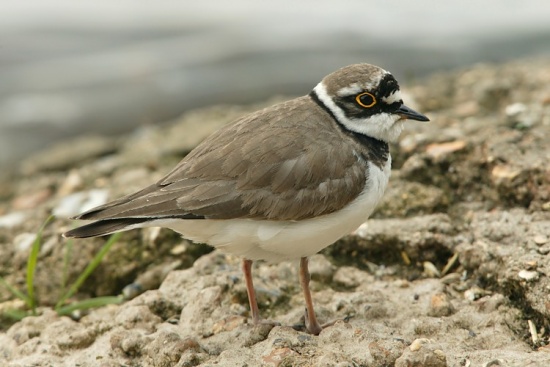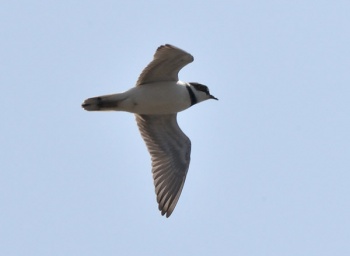
- Charadrius dubius
Identification
17cm
- Greyish-brown back and wings,
- White belly and breast
- Black neckband
- Brown cap
- White forehead and supercillium
- Black facial mask
- Yellow eye ring
- Short dark bill
- Flesh-coloured legs.
Similar Species
This species is very similar to the slightly larger Common Ringed Plover. The most obvious differences are the prominent yellow eye ring and all black bill in the Little Ringed Plover. Its legs are also reddish compared with the orange legs of the Common Ringed Plover. In flight it lacks the obvious wing bar of the larger species. On the ground, it is slightly duller and 'sleeker', with a more horizontal carriage - giving it an often rather 'furtive' appearance compared to its bolder larger cousin.
Distribution
Eurasia, Africa and Australasia. Rare breeder in Scotland
Taxonomy
Subspecies
There are 3 subspecies1:
- C. d. curonicus - breeds Palearctic; winters to Africa, Arabia, eastern China and Indonesia
- C. d. jerdoni - India and south-eastern Asia
- C. d. dubius - Philippines to New Guinea and Bismarck Archipelago
Habitat
Gravel pits, islands and river edges - rarely far from fresh water.
Behaviour
Breeding
They nest on the ground on stones with little or no plant growth. The normal brood is three or four and they are sometimes double-brooded. The eggs hatch after about 25 days and the fledging period is similar. Within a short time of hatching the young birds can move very quickly, resembling tiny fluffy clockwork toys with legs looking disproportionately large. They are vulnerable to predation at this stage from crows, gulls and mammals. As a Schedule 1 species in the UK they enjoy special protection. It is illegal knowingly to disturb them during the breeding season. After a few weeks they look like faded versions of the adults.
Diet
These birds forage for food on muddy areas, and the diet includes insects and worms.
Vocalisation
<flashmp3>Charadrius dubius (song).mp3</flashmp3>
Listen in an external program
References
- Clements, J. F., T. S. Schulenberg, M. J. Iliff, D. Roberson, T. A. Fredericks, B. L. Sullivan, and C. L. Wood. 2015. The eBird/Clements checklist of birds of the world: v2015, with updates to August 2015. Downloaded from http://www.birds.cornell.edu/clementschecklist/download/
- Wikipedea
- Collins Field Guid 5th Edition
Recommended Citation
- BirdForum Opus contributors. (2024) Little Ringed Plover. In: BirdForum, the forum for wild birds and birding. Retrieved 26 April 2024 from https://www.birdforum.net/opus/Little_Ringed_Plover
External Links




